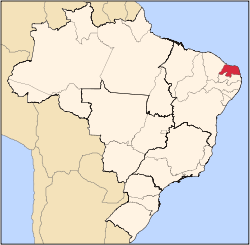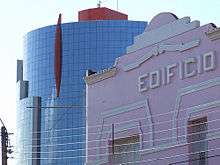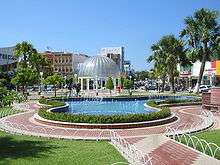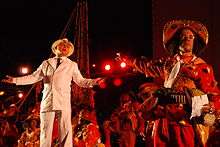Mossoró
Mossoró (Portuguese pronunciation: [mosoˈɾɔ]) is the second most populous city[2] in the state of Rio Grande do Norte, Brazil, and also the largest municipality of that state. It is equidistant (four hours' drive) from Natal (approximately 277 km or 172 miles), the state capital of Rio Grande do Norte, and from Fortaleza (approximately 260 km or 161.5 miles), the capital of the state of Ceará. It is also in the heart of Brazil's salt production area. Situated in the Oeste Potiguar mesoregion, Mossoró is the country's largest land-based petroleum producer.[3]
Mossoró | |
|---|---|
Municipality | |
| The Municipality of Mossoró | |
.jpg) | |
 Flag  Seal | |
| Nickname(s): "Capital do Oeste" ("The Capital of the West") and "Cidade do Sal e do Petróleo" ("City of Salt and Petroleum") | |
| Motto(s): Mossoró da gente. Fazendo nossa vida melhorar. (Our Mossoró. Improving our lives.) | |
 Location in the Rio Grande do Norte | |
 Location of State of Rio Grande do Norte in Brazil | |
| Coordinates: 5°11′16″S 37°20′38″W | |
| Country | |
| Region | Northeast |
| State | |
| Founded | 1852 |
| Government | |
| • Mayor | Rosalba Ciarlini Rosado (PP) |
| Area | |
| • Total | 2,110.207 km2 (814.755 sq mi) |
| Elevation | 20 m (66 ft) |
| Population (2018 est.[1]) | |
| • Total | 294,076 |
| • Density | 140/km2 (360/sq mi) |
| Time zone | UTC-3 (America/Fortaleza) |
| • Summer (DST) | UTC-3 (DST Not Observed) |
| Postal Code | 59600 |
| ISO 3166 code | BR-RN |
| HDI (2000) | 0.735 – medium |
| Website | www |
History
To Brazilians, the main historical distinctions of the city are the driving off an attack by Lampião and his gang of "social bandits" (see Cangaço) that plundered entire towns in the sertão during the 1920s and 1930s; and also the fact that the city freed its slaves five years before the Lei Áurea abolished slavery in the rest of the country in 1888. Mossoró was also the first city to give women the right to vote in Brazil (Professor Celina Guimarães Viana cast the first vote in 1928), sparking a movement among other cities and states in Brazil that culminated in the official recognition of women's suffrage by the national government in 1934.
Population Growth
|
| |||||||||||||||||||||||||||
| *The IBGE population estimate for Mossoró as of 2010 stands at 259,886 people[4] (96th largest municipality in Brazil). | ||||||||||||||||||||||||||||
Culture and Recreation

Although it does not have beaches within its city limits, there are several magnificent beaches in the surrounding area of the Costa Branca Pole such as the desert beaches of the city of Areia Branca. World-famous Canoa Quebrada beach is a short drive away in the neighboring state of Ceará.
The Resistance Museum tells the story of the city and the city's native sons. However, the most famous attraction is the Mossoró Cidade Junina (Mossoró Junina City Festival), a winter festival (festa junina) that attracts more than a million people during the month of June.
The city has a beautiful historic town, a hub of fascinating stories of the region's development. Main attractions include the Museu Municipal Jornalista Lauro da Escóssia (Journalist Lauro da Escóssia Municipal Museum), also known as the Cangaço Museum, the Station Arts old railway station museum, the Oil Museum, St. Vincent Church, and the Cathedral of Santa Luzia. Other attractions include the famous Palace of Resistance, former residence of mayor Rodolfo Fernandes who was the leader of the resistance against the "Lamp band" (Lampião) and served as a rampart against attacks from those notorious bandits. There is also the Bode Market, an ovine and caprine trading center where traders and buyers of sheep and goats continue the long-held rural traditions of the northeast, as well as the famous Central Market and the Railway Bridge.
In September, the city stages what could be the largest play in the world, the Auto Da Liberdade (The Procession of Liberty) with an all-paid cast of 2,000 and a 600-member chorus as part of its Festa da Liberdade (Brazilian independence celebrations).
Mossoró also has a shopping center, Mossoró West Shopping, which includes a 5-screen multiplex cinema, Wi-Fi internet connectivity, children's recreation and diaper changing area, ATMs, bowling alley, pharmacy, and food court among its many amenities.
Mossoró is also home to the Hotel Thermas Resort which is the largest thermal water park in Brazil. The heated water used in the resort arises from a zone of geothermal hot springs located in the vicinity of the city.
The city is the seat of the Roman Catholic Diocese of Mossoró.[5][6]
 Canoa Quebrada Beach
Canoa Quebrada Beach Ponta do Mel, Areia Branca
Ponta do Mel, Areia Branca Mossoró Old City Hall
Mossoró Old City Hall Rodolfo Fernandes Square
Rodolfo Fernandes Square
Education
Colleges and Universities
The Federal University of the Semi-Arid is located in Mossoró.
The following have campuses in the city:
Grade Schools and High Schools
You can see a listing of public and private elementary, junior, and senior high schools in Mossoró HERE (In Portuguese.) UNP universidade Potiguar
Regional Transportation

Airports
Mossoró is served by the following airports:
- Mossoró Airport (Dix-Sept Rosado Airport) - 2.7 km away
- Aeroporto Internacional de Fortaleza (Pinto Martins International Airport) - 205.2 km away
- Aeroporto Internacional de Natal/Augusto Severo International Airport (Wikipedia page) - 245.8 km away (will be handed over to the Brazilian Air Force at the end of 2013)
- Aeroporto Internacional da Grande Natal or Greater Natal International Airport was scheduled to open in 2014 in time for the 2014 FIFA World Cup.
Highways
- BR-304
- BR-110
- BR-405
- BR-437
Distances to other Brazilian Cities
- São Paulo: 2,274 km (1,413 mi)
- Rio de Janeiro: 2,070 km (1,290 mi)
- Brasília: 1,652 km (1,027 mi)
- Salvador: 876 km (544 mi)
- Belo Horizonte: 1,779 km (1,105 mi)
- Curitiba: 2,588 km (1,608 mi)
- Porto Alegre: 3,126 km (1,942 mi)
- Manaus: 2,529 km (1,571 mi)
Climate
Mossoró is one of the hottest cities in all of Brazil. It is not uncommon for temperatures to exceed 35 °C (95 °F) throughout the year, with temperatures approaching 45 °C (113 °F) unexceptional. A fairly short wet season spans from January to May, while the scorching dry season spans the remainder of the year. The sultriest temperatures are registered from October to January.
It has semi-arid climate with a temperature range of mean lows around 22.7 °C (72.9 °F) in winter and mean highs around 33.4 °C (92.1 °F) in summer.[7]
| Climate data for Mossoró | |||||||||||||
|---|---|---|---|---|---|---|---|---|---|---|---|---|---|
| Month | Jan | Feb | Mar | Apr | May | Jun | Jul | Aug | Sep | Oct | Nov | Dec | Year |
| Average high °C (°F) | 34.1 (93.4) |
33.3 (91.9) |
32.6 (90.7) |
32.3 (90.1) |
32.3 (90.1) |
32.3 (90.1) |
32.5 (90.5) |
33.8 (92.8) |
34.4 (93.9) |
34.6 (94.3) |
34.6 (94.3) |
34.4 (93.9) |
33.4 (92.1) |
| Daily mean °C (°F) | 26.8 (80.2) |
25 (77) |
27.3 (81.1) |
27.3 (81.1) |
27 (81) |
26.7 (80.1) |
26.5 (79.7) |
27.1 (80.8) |
27.7 (81.9) |
28.1 (82.6) |
28.3 (82.9) |
28.7 (83.7) |
27.2 (81.0) |
| Average low °C (°F) | 23.7 (74.7) |
23.5 (74.3) |
23.3 (73.9) |
23.2 (73.8) |
22.8 (73.0) |
21.9 (71.4) |
21.6 (70.9) |
21.3 (70.3) |
21.9 (71.4) |
22.8 (73.0) |
23.2 (73.8) |
23.6 (74.5) |
22.7 (72.9) |
| Average rainfall mm (inches) | 69.3 (2.73) |
130.1 (5.12) |
169.2 (6.66) |
179.6 (7.07) |
109.5 (4.31) |
49.4 (1.94) |
39.9 (1.57) |
11.1 (0.44) |
5.9 (0.23) |
3.4 (0.13) |
3.2 (0.13) |
17.3 (0.68) |
787.9 (31.02) |
| Average relative humidity (%) | 67 | 72 | 78 | 74 | 76 | 72 | 69 | 62 | 61 | 62 | 63 | 66 | 68.5 |
| Mean monthly sunshine hours | 231.7 | 194.4 | 186.4 | 190.3 | 217.1 | 211.3 | 228.3 | 269.1 | 271.7 | 290.3 | 281 | 256.5 | 2,828.1 |
| Source 1: Climate Charts (daily means and humidity);[7] | |||||||||||||
| Source 2: Brazilian National Institute of Meteorology - INMET (rainfall and sun: 1961-1990).[8][9] | |||||||||||||
Images
 Memorial da Resistência (Resistance Memorial)
Memorial da Resistência (Resistance Memorial) Mossoró Cidade Junina (Mossoró City Junina Festival)
Mossoró Cidade Junina (Mossoró City Junina Festival) Petroleum Extraction
Petroleum Extraction.jpg) Cathedral of Santa Luzia
Cathedral of Santa Luzia
See also
- List of cities
- List of major cities in Brazil
- List of municipalities of Brazil
- Municipalities of Rio Grande do Norte (RN)
References
- "Brazilian Institute of Geography and Statistics" (PDF) (in Portuguese). 2018. Retrieved 6 March 2019.
2018 Estimates of Population
- http://www.ibge.gov.br/cidadesat/link.php?uf=rn
- http://www.anp.gov.br/brasil-rounds/round4/round4/workshop/restrito/ingles/Potiguar_ing.pdf
- "Brazilian Institute of Geography and Statistics". 2010. Archived from the original on 2012-04-30. Retrieved 2010 Census - First results.
IBGE - Cities@
Check date values in:|accessdate=(help) - http://www.catholic-hierarchy.org/diocese/dmoss.html
- http://www.gcatholic.org/dioceses/diocese/moss2.htm
- "Mossoro, Brazil: Climate, Global Warming, and Daylight Charts and Data". Climate Charts. Archived from the original on June 5, 2014. Retrieved September 8, 2014.
- "Precipitação Acumulada Mensal e Anual (mm)" (in Portuguese). Brazilian National Institute of Meteorology. 1961–1990. Archived from the original on August 8, 2014. Retrieved September 8, 2014.
- "Insolação Total (horas)". Brazilian National Institute of Meteorology. Archived from the original on August 8, 2014. Retrieved September 8, 2014.
External links
| Wikimedia Commons has media related to Mossoró. |
| Wikisource has original text related to this article: |
- (in Portuguese) Official Website
- (in Portuguese) Mossoró Cidade Junina Official Site
- (in Portuguese) LFG
- (in Portuguese) Federal University of the Semi-Arid
- (in Portuguese) De Fato Newspaper
- (in Portuguese) Thermas Resort